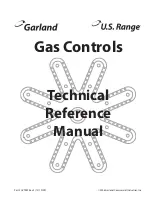
Part # 4500195 (02/20/08)
Page 9
A strong exhaust will create a vacuum in the room. For an
exhaust vent to work properly, replacement air must enter
the room. The amount of air that enters must be equal to the
amount exhausted.
All gas burners and pilots need sufficient air to operate. Large
objects should not be placed in front of the appliance(s),
which would obstruct the flow of air into the front.
INSTALLATION Continued
TESTING & ADJUSTMENT
All fittings and pipe connections must be tested for
leaks. Use approved gas leak detectors, soap solution or
equivalent, checking over and around all the fittings and
pipe connections. DO NOT USE A FLAME! Accessibility to
all gas lines and fittings require that valve panel(s), lower
front panel(s), and/or oven rack(s) be removed. It may be
necessary to remove, or at least raise and securely prop
griddles, hot top, and/or top grates. All parts removed,
(including fasteners), should be stored safely for re-
installation.
1. Be sure that all valves and thermostats are in the “OFF”
position.
2
Turn on the main gas supply valve. Light all top section
pilots.
3. Leak test all valves and fittings as described at the
beginning of this section. Correct any leaks as required
and recheck.
4. Light the oven pilot.
5. If the range is equipped with an oven on/off valve
separate from the thermostat, turn this valve on. If
the oven thermostat dial has an “OFF” position the
thermostat is its own on/off valve.
6. In either case, now set the thermostat to 500°F (260°C).
Leak test all valves and fittings as described at the
beginning of this section. Correct any leaks as required
and recheck.
7. Shut off all valves and set thermostat dials to “OFF” or
lowest position.
All units are tested and adjusted at the factory, however,
burners and pilots should be checked upon installation and
adjusted if necessary.
CAUTION: Gas will flow to the top section burners even if
top section pilots are not lit. Gas will not be interrupted. It
is the responsibility of the operator to confirm the proper
ignition of each burner as it is turned on. Should ignition
fail to occur 5 seconds after turning a burner on, turn the
burner off, wait 5 minutes, and try again.
Griddle Seasoning
1. Remove all factory applied protective material by
washing with hot water, mild detergent or soap solution.
2. Apply a thin coat of cooking oil to the griddle surface,
about one-ounce per square foot of griddle surface.
Spread over the entire griddle surface with a cloth to
create a thin film. Wipe off any excess oil with a cloth.
3. Light burners, set at lowest possible setting. Some
discoloration will occur when heat is applied to steel.
4. Heat griddle slowly for 15 to 20 minutes. Then wipe away
oil. Repeat the procedure 2 to 3 times until the griddle
has a slick, mirror-like finish. Do this until you have
reached the desire cooking temperature.
IMPORTANT: Do not attain high (on valve control) or 450°F
(on thermostat control) during “break-in” period.










































